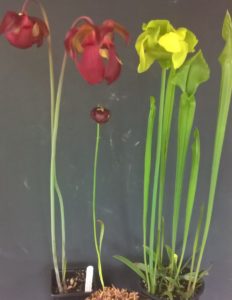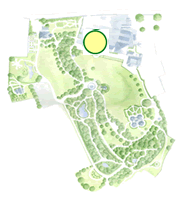Sarracenia sp.
Plant of the month: May
 |
 |
Also Known As: Pitcher Plant
Native To: North America (in numerous north, east and southeast states, depending on the species)
Blooms: Spring
Habitat: Peat bogs and swamps
Where Found At BBG: Subtropical House
Like many carnivorous plants, Sarracenia grows in nutrient-poor soils and has evolved to catch insects, providing it with much-needed nutrients. Sarracenia plants have modified leaves (traps) that consist of a vertical cone with an opening at the top and a lid. Insects are attracted to the pitchers by their smell, colouration, and nectar. They then slip on the waxy smooth lip into the pitcher, where inward pointing hairs prevent escape and digestive enzymes break the insects down.
The flowers, between 3–10 cm in diameter (depending on species) are dramatic and have an elaborate design, similar to an umbrella, which prevents self-pollination.
Each consist of five sepals surrounded by three bracts, numerous anthers and an umbrella-like five-pointed style, over which five long yellow or red petals dangle. The whole inflorescences (flowers) are held upside-down, so that the umbrella-like style catches the pollen dropped by the anthers. Stigmas are located at the tips of the umbrella-like style.
Sarracenia primary pollinators are bees. The bees, searching for nectar, must force their way past one of the stigmas to enter the chamber and then once inside they come into contact with a large amount of pollen, both from the hanging anthers and from the pollen collected by the style. Upon exiting, the bees must force their way under one of the flap-like petals, and then will fly off to another plant. This keeps them away from the stigma, which also stops self-pollination.
Keep the plants moist at all times by sitting it in trays of rain water (tap water can kill them, as can fertiliser). Never allow them to dry out – a dried Sarracenia is a dead one!

